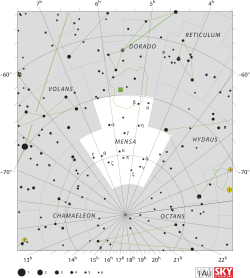- Mensa (constellation)
-
Mensa Constellation 
List of stars in MensaAbbreviation Men Genitive Mensae Pronunciation /ˈmɛnsə/, genitive /ˈmɛnsiː/ Symbolism the Table Mountain Right ascension 4 ~ 7.5 h Declination −71 ~ −85.5° Quadrant SQ1 Area 153 sq. deg. (75th) Main stars 4 Bayer/Flamsteed
stars16 Stars with planets 2 Stars brighter than 3.00m none Stars within 10.00 pc (32.62 ly) none Brightest star α Men (5.09m) Nearest star α Mensae
(33.10 ly, 10.15 pc)Messier objects none Meteor showers none Bordering
constellationsChamaeleon
Dorado
Hydrus
Octans
VolansVisible at latitudes between +4° and −90°.
Best visible at 21:00 (9 p.m.) during the month of January.Mensa is a constellation in the southern sky, created in the 18th century. Its name is Latin for table. It covers a keystone-shaped wedge of sky stretching from approximately 4h to 7.5h of right ascension, and −71 to −85.5 degrees of declination. Other than the south polar constellation of Octans, it is the most southerly of constellations. As a result, it is essentially unobservable from the Northern Hemisphere. Besides those already mentioned, its other neighbouring constellations are Chamaeleon, Dorado, Hydrus and Volans.
Contents
History
Mensa was created by Nicolas Louis de Lacaille under the name Mons Mensae, the Latin name for Table Mountain in South Africa, where Lacaille made important early observations of the southern sky.
Notable features
Stars
Mensa contains no bright stars, with Alpha Mensae its brightest star at a barely visible magnitude 5.09, making it the faintest constellation in the entire sky. Alpha Mensae is a solar-type star (class G5 V) 33 light-years from Earth, and is considered a good prospect for harboring an Earth-like planet. Pi Mensae, on the other hand, while also solar-type (G1) and at 59 light-years, has been found to have a large gas giant in an eccentric orbit crossing the habitable zone, which would effectively rule out the existence of any habitable planets.
Deep sky objects
Mensa contains part of the Large Magellanic Cloud (the rest being in Dorado).
The first images taken by the Chandra X-Ray Observatory were of PKS 0637-752, a quasar in Mensa with a large gas jet visible in both optical and x-ray wavelengths.
References
- Ian Ridpath and Wil Tirion (2007). Stars and Planets Guide, Collins, London. ISBN 978-0007251209. Princeton University Press, Princeton. ISBN 978-0691135564.
External links
Andromeda · Antlia · Apus · Aquarius · Aquila · Ara · Aries · Auriga · Boötes · Caelum · Camelopardalis · Cancer · Canes Venatici · Canis Major · Canis Minor · Capricornus · Carina · Cassiopeia · Centaurus · Cepheus · Cetus · Chamaeleon · Circinus · Columba · Coma Berenices · Corona Australis · Corona Borealis · Corvus · Crater · Crux · Cygnus · Delphinus · Dorado · Draco · Equuleus · Eridanus · Fornax · Gemini · Grus · Hercules · Horologium · Hydra · Hydrus · Indus · Lacerta · Leo · Leo Minor · Lepus · Libra · Lupus · Lynx · Lyra · Mensa · Microscopium · Monoceros · Musca · Norma · Octans · Ophiuchus · Orion · Pavo · Pegasus · Perseus · Phoenix · Pictor · Pisces · Piscis Austrinus · Puppis · Pyxis · Reticulum · Sagitta · Sagittarius · Scorpius · Sculptor · Scutum · Serpens · Sextans · Taurus · Telescopium · Triangulum · Triangulum Australe · Tucana · Ursa Major · Ursa Minor · Vela · Virgo · Volans · VulpeculaNearby LDS 169Coordinates:
 05h 00m 00s, −80° 00′ 00″Categories:
05h 00m 00s, −80° 00′ 00″Categories:- Mensa constellation
- Constellations
- Southern constellations
- Eastern constellations
- Astronomy stubs
Wikimedia Foundation. 2010.
